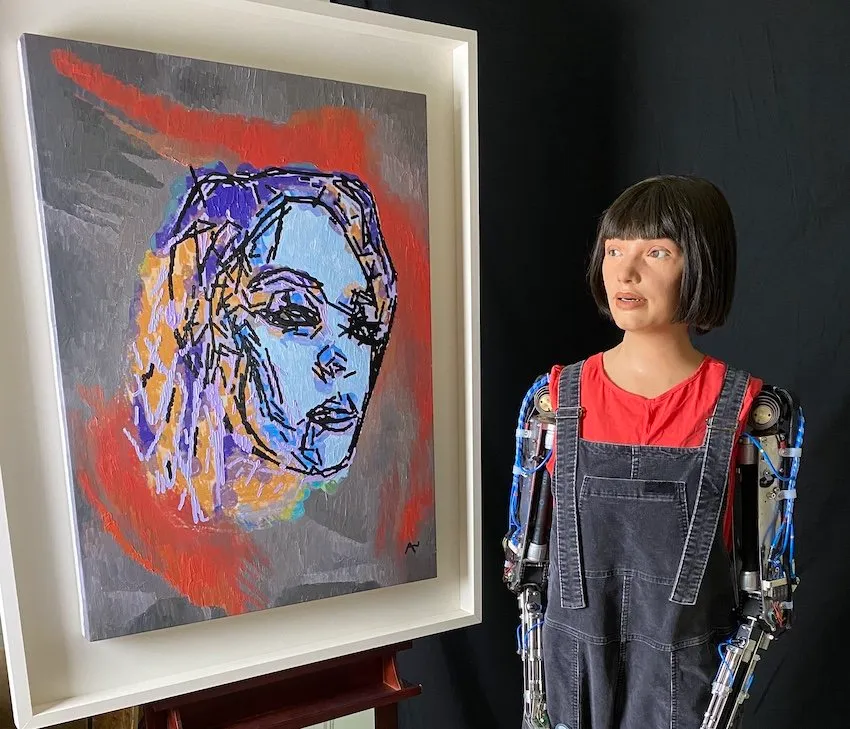When in 2019, when a robot called “ai-da” was unveiled, the worlds of art and technology became closer than ever. Aida, the robot that was designed and built by Aidan Mahler and Lucy Seale, was able to create drawings that quickly attracted attention while demonstrating the capabilities of artificial intelligence. The question that arises here is, can robots become artists or are they just advanced tools that are guided by humans?
Drawing of the robot Aida; Combining art and artificial intelligence
Aida, the robot that was first introduced in February 2019, challenged many concepts and ideas related to art and creativity. This robot, which has a human appearance, is specifically able to draw using its robotic arms. “Adel Haroyan”, painter and researcher of contemporary art, says about this: “Aida’s unique feature is not only in her mechanical abilities. This robot is able to observe the world around it and create abstract paintings based on it using eye cameras embedded in its eyes.
“Initially, Ida managed to attract a lot of attention by drawing a picture of Lucy Seal,” he continued. This move was only the beginning of what would later become one of the greatest achievements of artificial intelligence in the art world.”
artificial intelligence; Art or technology?
With the rapid growth of artificial intelligence technologies and the development of image production models with the help of artificial intelligence, the question arises, can a robot or an artificial intelligence be an artist? From Adel Haroyan’s point of view, Aida is not an artist but a tool that is guided by humans. “As a robot, Ida is nothing more than an advanced tool,” he said. Just like a camera that cannot create a work of art by itself, Aida is only able to produce images based on the algorithms given to it.
This view strongly contradicts the concept of art in the contemporary world. Because in many of today’s arts, unlike the past, art uses new tools and technologies to expand the boundaries of creativity. But it seems that Aida reflects the achievements of the human mind more than being an artist herself.
Aida’s paintings; Analysis from the perspective of art
The paintings that Aida creates, although technically a bit sophisticated, none of them display a deep understanding of the concept of human art. Aida uses data and inputs provided by humans to create its works.
In fact, Aida does not have any kind of feelings or experiences that she wants to use to create a work of art. This robot is just an advanced tool that produces its drawings based on the training it has received.
Adel Haroyan said: “Aida’s paintings, although they look beautiful and complex, are actually nothing more than the reconstruction and combination of previous models. “These paintings can be similar to the works of great historical artists, but none of them have artistic originality.”


Selling Aida’s paintings; Revolution or deception?
The works of art produced by Ida were not only appreciated by critics, but also sold in art markets. One of Ida’s paintings titled “Alan Turing” was sold at an auction for a huge price. This issue led to new questions about the value and place of artificial intelligence art in the contemporary world.
Aidan Mahler, the owner of the Aida project, has mentioned in an interview that he and Lucy Seale started the project with the aim of demonstrating the capabilities of artificial intelligence in art. But can Aida’s paintings really have artistic value or is it just a clever hoax that has managed to challenge the art world?


Finally, can Ida be considered an artist? Adel Hrovian says about this: “Aida cannot be an artist, because she does not have any self-awareness or human feelings. What Aida produces is only the output of the commands and data it is given. “In fact, Aida is a kind of smart printer that produces works of art from the information given to it.”
This comment indirectly raises the question of whether art can be created without humans and without human emotions. It seems that the art world is experiencing a new revolution in which technology and artificial intelligence can play new roles, but still for many artists and critics, the value of art depends on human feeling, experience and gaze.


The Aida project and its paintings, rather than being about art, refer to fundamental questions about technology, creativity, and artificial intelligence. In today’s world, where technology is advancing rapidly, robots and artificial intelligence can be very powerful tools for producing works of art. But does that mean they can be recognized as artists? This is a question that still does not have a definitive answer and is still being discussed in the art world.
RCO NEWS















